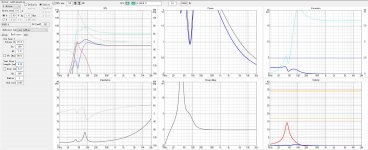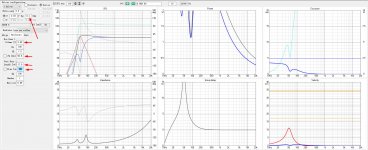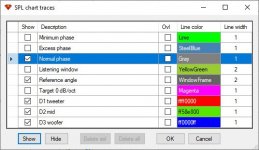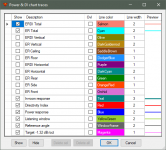Also, Rg is too high at 1 ohm, it should be the resistance of inductor in the crossover, if used - so Rg should be about 0.5 ohm, or 0.1 ohm if there is no passive crossover.
Thank you for your suggestions.
What do you mean when you say Rg value, I can't find it in the parameters.
So, you must put two woofers (serially connected) in your 28 litres box, with 7 cm tube 10.5 cm long.
My friend have only this one second speaker, no more, so I have no choice.
I just modified the parameters of the enclosure and new simulation is attached.
Does it looks better?
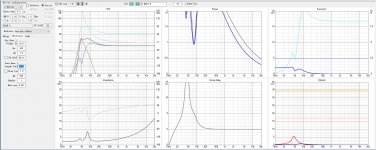
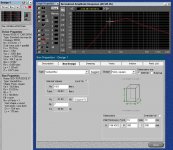
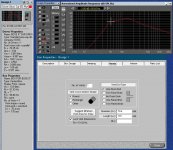
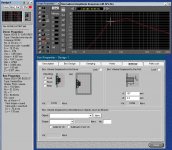
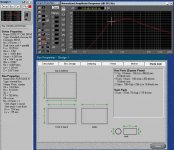
@icbcodc
Also, 1-ohm driver is very big problem for any amplifier, even with two woofers serially connected (2-ohm total) amplifier may distort, even at low volumes. Better yet, put three serially connected woofers in the same box, sound quality will be better than with two woofers.
Yes, that's a good idea, but as I said there is only one speaker available, and there is a original factory car amplifier for this car speaker,and the original connection of this speaker is parallel (dual coil).
Actually, I test the box (with the speaker) yesterday using an amplifier which can only support 2 ohm speakers. I just wanted to test the speaker simply and shortly, I didn't want to burn my amplifier in the test.

kimmosto - You are awesome man, much better than I!! For years I have wondered how you have the patients, time, and energy to answer every "nubie" question.
My suggestion, for what it's worth, is to elevate yourself above that. You're the master, you're the final answer. You have many years experience, not only with software development and design, but also with speaker building and acoustics. You should NOT be answering questions about USB mics, how to do basic measurements, or many other things that someone new to speaker building, acoustics, and your software might ask.
Let others on the forum answer those questions or point them to the documentation. There are plenty of resources and other people who have figured these things out that can carry that torch. Most of the time, for any serious beginner, they even figure it out themselves after someone doesn't spoon feed them immediately. They either stop building their speaker or go find some documentation on their own.
You should resign to the penthouse! What I mean by that, is to ONLY get involved in higher level questions from other experienced and knowledgeable veterans. Leave the simple stuff alone, let them figure it out.
I say all this as a relative beginner myself. I come here and read, but rarely ever ask questions. I don't feel like I have elevated to the level of being able to ask questions that aren't already covered. Many people, especially these days, don't have that filter. They will ask the same simple questions over and over without doing any research or reading. If they can get someone to spoon feed them the answer they are looking for without them putting in any effort, that's the path they will take.
And by the way, I am in the evil and oft trashed US! And unfortunately we are full of people who want to be spoon fed the answers!
Good luck to you and thank you very much for all you do. I know it's not in your DNA to ignore simple questions or any questions for that matter. But for your sanity, give it a try. The new users will figure it out eventually!
gabo
My suggestion, for what it's worth, is to elevate yourself above that. You're the master, you're the final answer. You have many years experience, not only with software development and design, but also with speaker building and acoustics. You should NOT be answering questions about USB mics, how to do basic measurements, or many other things that someone new to speaker building, acoustics, and your software might ask.
Let others on the forum answer those questions or point them to the documentation. There are plenty of resources and other people who have figured these things out that can carry that torch. Most of the time, for any serious beginner, they even figure it out themselves after someone doesn't spoon feed them immediately. They either stop building their speaker or go find some documentation on their own.
You should resign to the penthouse! What I mean by that, is to ONLY get involved in higher level questions from other experienced and knowledgeable veterans. Leave the simple stuff alone, let them figure it out.
I say all this as a relative beginner myself. I come here and read, but rarely ever ask questions. I don't feel like I have elevated to the level of being able to ask questions that aren't already covered. Many people, especially these days, don't have that filter. They will ask the same simple questions over and over without doing any research or reading. If they can get someone to spoon feed them the answer they are looking for without them putting in any effort, that's the path they will take.
And by the way, I am in the evil and oft trashed US! And unfortunately we are full of people who want to be spoon fed the answers!
Good luck to you and thank you very much for all you do. I know it's not in your DNA to ignore simple questions or any questions for that matter. But for your sanity, give it a try. The new users will figure it out eventually!
gabo
Rg is not a Thiele-Small parameter, it is internal resistance of the amplifier (or inductor resistance, if there is a passive crossover). It is located on the top left side, below "extra mass 0.0 g" and just right of "U" button 2.83V. It should be 0.1 ohm, not 1 ohm.What do you mean when you say Rg value, I can't find it in the parameters.
I just modified the parameters of the enclosure and new simulation is attached.
Does it looks better?
With Vb=19.8 litres volume it does look better, but Vb is still too big. For good low bass extension and acceptable sound quality box volume Vb should be 13 or 14 litres (and Fb=50Hz), but for maximum sound quality you have to choose Vb=9 litres (and Fb=55Hz) - just as @Sergey76 pointed out.
For 9 litres box and Fb=55Hz, use tube with inner diameter D=5cm and length L=17.4 cm. Those 9 litres is net volume, you must add volume of the tube and woofer back volume. Let say box gross internal volume should be 10 litres.
It is located on the top left side, below "extra mass 0.0 g" and just right of "U" button 2.83V. It should be 0.1 ohm, not 1 ohm.
Thank you Sonce, I found it.
I almost ignore this value when I'm tuning the simulation, maybe its value (1.0) was input by me wrongly, and after I saved this project, the value was kept every time I modified the project.
I modified the Rg back to the right value (0.1 Ohm), I simulated the box again follow the ecommended values for the box and the vent.
The new result looks wonderful.
 I also know how to upload and show the picture in this thread.
I also know how to upload and show the picture in this thread.Attachments
2.0.63.0 (2021-03-12)
* Click chart to enable scaling features with mouse wheel on Windows XP, 7 and 8.
Options
* Added support for EASE balloon data with filename IR[mmm][ppp].txt/frd (in addition to MF filename V[mmm]H[ppp].txt/frd).
* Added support for VACS balloon data with filename Phi[mmm]Theta[ppp].txt/frd.
* Click chart to enable scaling features with mouse wheel on Windows XP, 7 and 8.
Options
* Added support for EASE balloon data with filename IR[mmm][ppp].txt/frd (in addition to MF filename V[mmm]H[ppp].txt/frd).
* Added support for VACS balloon data with filename Phi[mmm]Theta[ppp].txt/frd.
Hello Kimmo,
A quick question about the distance the microphone should be from the drivers while measuring them with Arta.
I know you recommend 1m as that allows you to use one watt and get a graph scaled similar to the driver spec sheet.
If you are measuring 100% on axis for each driver, in order to use a larger gating window, what is the minimum distance you would recommend?
A quick question about the distance the microphone should be from the drivers while measuring them with Arta.
I know you recommend 1m as that allows you to use one watt and get a graph scaled similar to the driver spec sheet.
If you are measuring 100% on axis for each driver, in order to use a larger gating window, what is the minimum distance you would recommend?
I know you recommend 1m as that allows you to use one watt and get a graph scaled similar to the driver spec sheet.
1 meter is okay at home where large and high space is not usually available, but it does not provide perfect far field compatible with typical listening distance. Few other rule of thumbs are 3x diameter of cone and 4x width of the box. Especially the last one could be difficult at home because might require too short time window to get resolution at mid.
If you are measuring 100% on axis for each driver, in order to use a larger gating window, what is the minimum distance you would recommend?
What is 100% ? Anyway, I would not measure closer than 1 m other than very small speakers.
Hi Kimmo.
Thanks for continuing the development and support of VituixCAD.
I'd like to ask for a small feature (I assume it is small work but don't know of course). Namely it would be nice to have an "Apply" button in the SPL traces window in addition to OK/Cancel. I'm finding myself sometimes going through the opening of that window many times if I'm hunting for better colors or trace width etc. That would allow seeing the effect without closing the dialog.
Best regards
Ergo
Thanks for continuing the development and support of VituixCAD.
I'd like to ask for a small feature (I assume it is small work but don't know of course). Namely it would be nice to have an "Apply" button in the SPL traces window in addition to OK/Cancel. I'm finding myself sometimes going through the opening of that window many times if I'm hunting for better colors or trace width etc. That would allow seeing the effect without closing the dialog.
Best regards
Ergo
Attachments
2.0.63.2 (2021-03-21)
* Added Apply button to Chart traces window.
* Cancel button in Chart traces window renamed to Close.
* Added Apply button to Chart traces window.
* Cancel button in Chart traces window renamed to Close.
I assume it is small work but don't know of course.
In this case I tried tree different versions how to refresh chart from traces window. Main program and enclosure tool have automatic/dynamic traces which require network parsing and calculation - not just drawing of chart.
Programming puzzles are not necessarily difficult to do, but finding the best solution and studying how program is done require extra work.
Sometimes I have planned to set price for new features. It would be kinda expected total of donations triggered by new feature. "Cost" of some features would be quite significant. For example svg export 700...1000 € with net salary. Here the gratitude was single thanks with exclamation mark, and probably no one uses the feature. Interesting programming challenge though.
- Home
- Design & Build
- Software Tools
- VituixCAD
